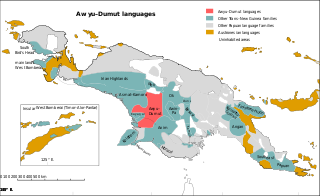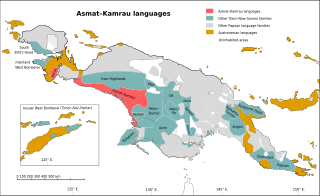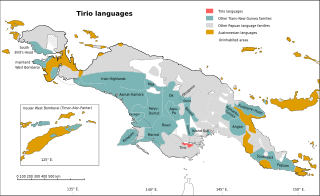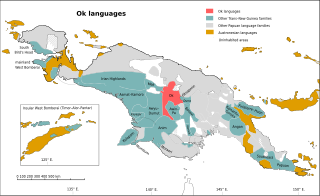Related Research Articles
The Sepik–Ramu languages are an obsolete language family of New Guinea linking the Sepik, Ramu, Nor–Pondo, Leonhard Schultze (Walio–Papi) and Yuat families, together with the Taiap language isolate, and proposed by Donald Laycock and John Z'graggen in 1975.

The Trans-Fly–Bulaka RiverakaSouth-Central Papuan languages form a hypothetical family of Papuan languages. They include many of the languages west of the Fly River in southern Papua New Guinea into southern Indonesian West Papua, plus a pair of languages on the Bulaka River a hundred km further west.

The Eastern Trans-Fly languages are a small independent family of Papuan languages spoken in the Oriomo Plateau to the west of the Fly River in New Guinea.

The Greater Awyu or Digul River languages, known in earlier classifications with more limited scope as Awyu–Dumut (Awyu–Ndumut), are a family of perhaps a dozen Trans–New Guinea languages spoken in eastern West Papua in the region of the Digul River. Six of the languages are sufficiently attested for a basic description; it is not clear how many of the additional names may be separate languages.

The Asmat – Kamrau Bay languages are a family of a dozen Trans–New Guinea languages spoken by the Asmat and related peoples in southern Western New Guinea. They are believed to be a recent expansion along the south coast, as they are all closely related, and there is little differentiation in their pronouns.

The Marind–Yaqai (Marind–Yakhai) languages are a well established language family of Papuan languages, spoken by the Marind-anim. They form part of the Trans–New Guinea languages in the classifications of Stephen Wurm and Malcolm Ross, and were established as part of the Anim branch of TNG by Timothy Usher.

The Kiwaian languages form a language family of New Guinea. They are a dialect cluster of half a dozen closely related languages. They are grammatically divergent from the Trans–New Guinea languages, and typically have singular, dual, trial, and plural pronouns.

The Kamula–Elevala languages are a small family of the Trans–New Guinea languages spoken in the region of the Elevala River.

The Tirio languages are a family of Trans–New Guinea languages in the classification of Malcolm Ross. The Tirio languages have about 40% of their lexicon in common.

The Ok languages are a family of about a dozen related Trans–New Guinea languages spoken in a contiguous area of eastern Irian Jaya and western Papua New Guinea. The most numerous language is Ngalum, with some 20,000 speakers; the best known is probably Telefol.
The Northern Adelbert or Pihom–Isumrud languages are a family of twenty languages in the Madang stock of New Guinea. The occupy the coastal northern Adelbert Range of mountains directly opposite Karkar Island, as opposed to the Southern Adelbert languages, another branch of Madang.

The Kainantu–Goroka languages are a family of Papuan languages established by Arthur Capell in 1948 under the name East Highlands. They formed the core of Stephen Wurm's 1960 East New Guinea Highlands family, and are one of the larger branches of Trans–New Guinea in the 2005 classification of Malcolm Ross.
Momuna (Momina), also known as Somahai, is a Papuan language spoken in Yahukimo Regency, Highland Papua and Asmat Regency, South Papua, Indonesia.
The Mailuan or Cloudy Bay languages are a small family of Trans–New Guinea languages spoken around Cloudy Bay in the "Bird's Tail" of New Guinea. They are classified within the Southeast Papuan branch of Trans–New Guinea.
The Yareban or Musa River languages are a small family of Trans–New Guinea languages spoken near the Musa River in the "Bird's Tail" of New Guinea. They are classified within the Southeast Papuan branch of Trans–New Guinea.
The Ramu languages are a family of some thirty languages of Northern Papua New Guinea. They were identified as a family by John Z'graggen in 1971 and linked with the Sepik languages by Donald Laycock two years later. Malcolm Ross (2005) classifies them as one branch of a Ramu – Lower Sepik language family. Z'graggen had included the Yuat languages, but that now seems doubtful.

The Bulaka River languages are a pair of closely related Papuan languages, Yelmek and Maklew, on the Bulaka River in Indonesian South Papua. They are ethnically Yab (Jab); their speech is Yabga (Jabga).
The Ataitan languages, also known as the Tanggu or Moam River languages, are a small family of clearly related languages spoken in the region of the Moam River in Papua New Guinea. They are,
The Arafundi languages are a small family of clearly related languages in East Sepik Province, Papua New Guinea. They are conjectured to be related to the Piawi and Madang languages. They are named after the Arafundi River.
The Oirata–Makasae, or Eastern Timor, languages are a small family of Papuan languages spoken in eastern Timor and the neighboring island of Kisar.